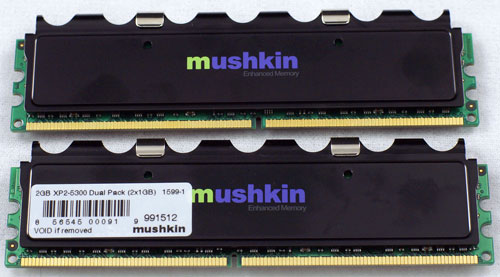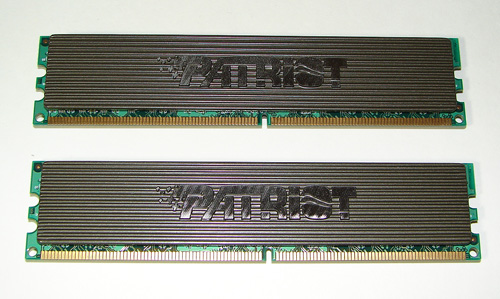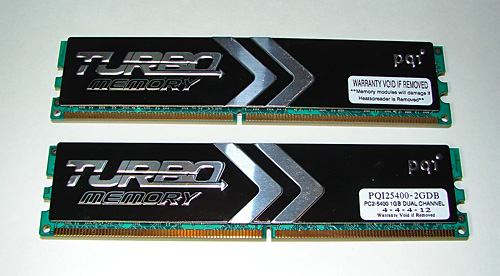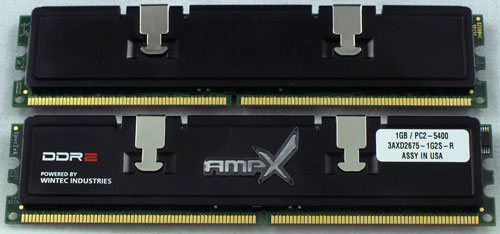Conroe Buying Guide: Feeding the Monster
by Gary Key & Wesley Fink on July 19, 2006 6:20 AM EST- Posted in
- Motherboards
Mushkin eXtreme DDR2-667

The Mushkin DDR2-667 memory arrived with the highest price in our value roundup, an excellent heat spreader design, but performed below average at the DDR2-667 and DDR2-800 settings. We raised the voltages but did not have any success in improving the timings at these settings. However, the Mushkin ran at stock voltages for the low latency DDR2-400 and DDR2-533 settings although the 3-3-3-8 timings at DDR2-533 could not be improved with additional voltage to match the 3-2-2-7 timings of other modules. Also, this is the only memory in our group that would not run 4-3-3 settings at DDR2-800. Although the performance difference is minimal, the cost of this kit indicates the memory should perform better.
Patriot DDR2-667

Patriot Memory provided their Extreme Performance series memory modules that provided above average performance at voltage settings that were more than acceptable for 24/7 operation. The memory comes with stylish heat spreaders and was able to easily clock up to DDR2-900 at extended voltages and 5-5-5-15 timings, though we recommend the lower latencies at DDR2-800.
PQI Turbo DDR2-667

The bargain of the bunch has to be the PQI Turbo kit that is currently selling for around $117 with rebate. While the timing performance of the memory was excellent we had to run at voltages higher than the group's average to meet these settings. The base voltage for this particular model is 2.0V, something to be aware of based upon our results with the other memory modules.
Wintec AMPX DDR2-667

The Wintec AMPX DDR2 Extreme series of memory was the pleasant surprise of the group as it generated excellent timings at low voltages at the lower memory speeds. It performed average at DDR2-800, although the results are more than acceptable.
Comparing Value Memory
All of the memory in the value section was able to run on average 4-3-3-9 settings at DDR2-800 except for the Mushkin modules that were limited to 4-4-4-12 but at a low 2.0V setting. The performance delta is extremely minor and the lower voltages are welcomed, but the Mushkin memory is the most expensive in our group so we naturally expect more from it.
The ability of all our value memory to run at very low latencies at DDR2-667 and 4-3-3-9 latencies at DDR2-800 is just incredible given the average price of $148 for a 2GB kit. Not even a year ago this type of performance in the DDR2 world would have placed this "value" memory at the top of performance charts. We found the Elpida memory to offer higher overclocks at lower memory voltages overall than the Infineon based modules, making it the current leader in value performance memory in our opinion.
The two modules that stood out were the A-Data Vitesta DDR2-533 and Wintec AMPX DDR2-667. During testing, both offered a unique combination of price, performance, and stability. All of the memory reviewed is more than acceptable for a Conroe system and the performance differences are so minor that we suggest choosing a supplier based upon prior experience, warranty, or price in this case. We will be looking at additional value memory modules from other suppliers shortly along with providing performance test results with our new Core 2 Duo Memory test platform.

The Mushkin DDR2-667 memory arrived with the highest price in our value roundup, an excellent heat spreader design, but performed below average at the DDR2-667 and DDR2-800 settings. We raised the voltages but did not have any success in improving the timings at these settings. However, the Mushkin ran at stock voltages for the low latency DDR2-400 and DDR2-533 settings although the 3-3-3-8 timings at DDR2-533 could not be improved with additional voltage to match the 3-2-2-7 timings of other modules. Also, this is the only memory in our group that would not run 4-3-3 settings at DDR2-800. Although the performance difference is minimal, the cost of this kit indicates the memory should perform better.
| Mushkin - DDR2-667 - 2x1GB Model # 991512 |
||
| CPU Ratio | Memory Speed |
Best Memory Timings (Voltage) |
| (4:3) | 400 DDR2 | 3-2-2-5 1.8V |
| (1:1) | 533 DDR2 | 3-3-3-8 1.8V |
| (4:5) | 667 DDR2 | 3-3-3-10 2.1V |
| (2:3) | 800 DDR2 | 4-4-4-12 2.0V |
Patriot DDR2-667

Patriot Memory provided their Extreme Performance series memory modules that provided above average performance at voltage settings that were more than acceptable for 24/7 operation. The memory comes with stylish heat spreaders and was able to easily clock up to DDR2-900 at extended voltages and 5-5-5-15 timings, though we recommend the lower latencies at DDR2-800.
| Patriot - DDR2-667 - 2x1GB Model # PDC22G5300LLK |
||
| CPU Ratio | Memory Speed |
Best Memory Timings (Voltage) |
| (4:3) | 400 DDR2 | 3-2-2-5 1.9V |
| (1:1) | 533 DDR2 | 3-2-3-7 1.9V |
| (4:5) | 667 DDR2 | 3-3-3-8 2.1V |
| (2:3) | 800 DDR2 | 4-3-3-8 2.1V |
PQI Turbo DDR2-667

The bargain of the bunch has to be the PQI Turbo kit that is currently selling for around $117 with rebate. While the timing performance of the memory was excellent we had to run at voltages higher than the group's average to meet these settings. The base voltage for this particular model is 2.0V, something to be aware of based upon our results with the other memory modules.
| PQI - DDR2-667 - 2x1GB Model # PQI25400-2GDB |
||
| CPU Ratio | Memory Speed |
Best Memory Timings (Voltage) |
| (4:3) | 400 DDR2 | 3-2-2-5 2.0V |
| (1:1) | 533 DDR2 | 3-2-2-7 2.0V |
| (4:5) | 667 DDR2 | 3-2-3-9 2.2V |
| (2:3) | 800 DDR2 | 4-3-3-9 2.2V |
Wintec AMPX DDR2-667

The Wintec AMPX DDR2 Extreme series of memory was the pleasant surprise of the group as it generated excellent timings at low voltages at the lower memory speeds. It performed average at DDR2-800, although the results are more than acceptable.
| Wintec AMPX - DDR2-667 - 2x1GB Model # 3AXD2675-1G2S-R |
||
| CPU Ratio | Memory Speed |
Best Memory Timings (Voltage) |
| (4:3) | 400 DDR2 | 3-2-2-5 1.8V |
| (1:1) | 533 DDR2 | 3-2-2-7 1.9V |
| (4:5) | 667 DDR2 | 3-3-3-8 2.15V |
| (2:3) | 800 DDR2 | 4-3-3-9 2.2V |
Comparing Value Memory
All of the memory in the value section was able to run on average 4-3-3-9 settings at DDR2-800 except for the Mushkin modules that were limited to 4-4-4-12 but at a low 2.0V setting. The performance delta is extremely minor and the lower voltages are welcomed, but the Mushkin memory is the most expensive in our group so we naturally expect more from it.
The ability of all our value memory to run at very low latencies at DDR2-667 and 4-3-3-9 latencies at DDR2-800 is just incredible given the average price of $148 for a 2GB kit. Not even a year ago this type of performance in the DDR2 world would have placed this "value" memory at the top of performance charts. We found the Elpida memory to offer higher overclocks at lower memory voltages overall than the Infineon based modules, making it the current leader in value performance memory in our opinion.
The two modules that stood out were the A-Data Vitesta DDR2-533 and Wintec AMPX DDR2-667. During testing, both offered a unique combination of price, performance, and stability. All of the memory reviewed is more than acceptable for a Conroe system and the performance differences are so minor that we suggest choosing a supplier based upon prior experience, warranty, or price in this case. We will be looking at additional value memory modules from other suppliers shortly along with providing performance test results with our new Core 2 Duo Memory test platform.










123 Comments
View All Comments
JarredWalton - Wednesday, July 19, 2006 - link
Erm... onboard sound isn't "legacy". As for the others, the instant you release something without floppy support, someone is going to want to install an OS that needs drivers on a floppy (XP). I still find BIOS updates to be far more successful when done from a floppy as well. Give it another year and the floppy might truly start to disappear; we just need better support for USB storage devices.Makaveli - Wednesday, July 19, 2006 - link
Could u elaborate little more on the painful part of going from the AMD system to the conroe.rjm55 - Wednesday, July 19, 2006 - link
What they said in the recommendations was pretty clear: "Most of our Reference systems have been based on AMD/AM2 for the last couple of years. To be honest, going back to some of those same systems after our Conroe testing, the differences are more obvious and painful than you might think. Conroe is clearly the faster platform - and not by small, barely measurable differences."They said it was painful going back to the slower AMD systems for some testing after working with all these Conroe boards.
phusg - Thursday, July 20, 2006 - link
I think Makaveli's point is how is is slower? Gaming, switching apps, overall? I'm interested in some elaboration on this point too.mine - Wednesday, July 19, 2006 - link
missed the abit ab 9 proonly 965 board so far that showed some improvements in real wotld apps. over the 975.
but great review so far ...wait for more ..
Gary Key - Wednesday, July 19, 2006 - link
We really wanted to include the Abit AB9 Pro, however we did not have time to fully test the latest bios that unlocks the memory timings. We did not feel it would be fair to the readers or Abit to publish numbers until we had a shipping bios for review. I will not go through another a review of system with a bios that is not going to be released. ;-) We will post a follow up once we have concluded our testing.DeathSniper - Wednesday, July 19, 2006 - link
On page 3:I'm thinking you wanted to use 'coarse'? :D
Wesley Fink - Wednesday, July 19, 2006 - link
Our grammar checking software needs an education :D Fixed.archcommus - Wednesday, July 19, 2006 - link
Once again you guys continue to impress me. Can't think of another site that delivers this much (and this high quality) content.Thanks for keeping us informed!
vmsein - Wednesday, July 19, 2006 - link
Hello gentlemen and thanks for the informative article. Could you let us know which BIOS version was used for testing on the P5W-DH? Thanks in advance!